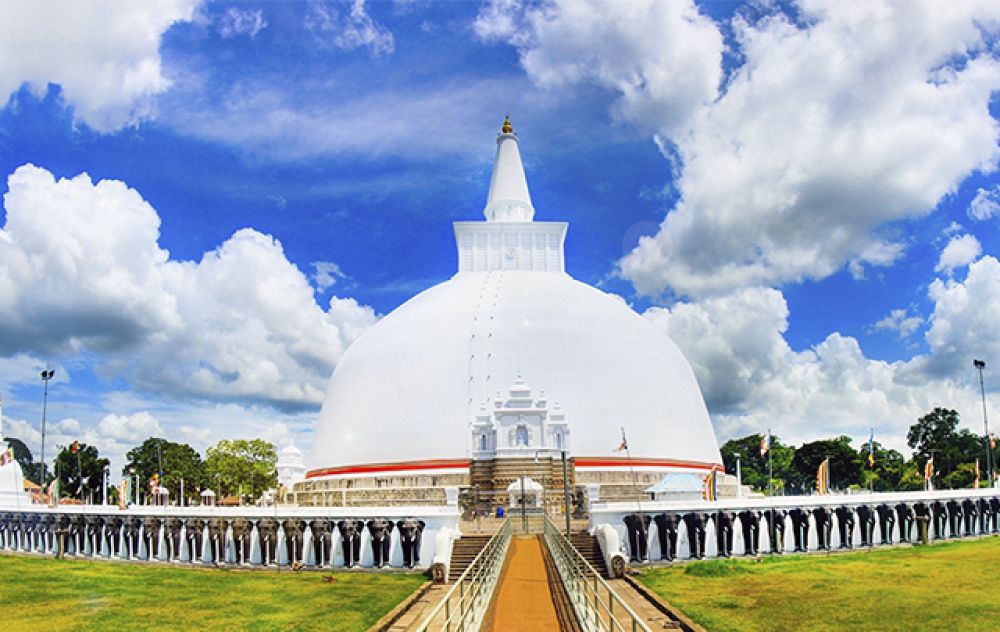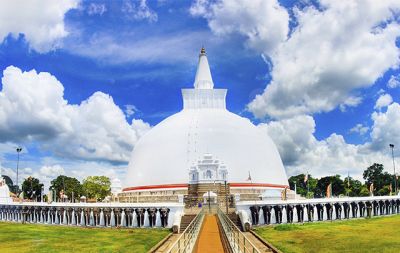

Anuradhapura is one of the ancient capitals of Sri Lanka and a UNESCO World Heritage Site. Visiting this sacred city is an immersive journey through Sri Lankan history and Buddhism. The city is dotted with majestic dagobas (stupas), ancient pools, and crumbling temples. Key sights include the Sri Maha Bodhi Tree, an offshoot of the tree under which Buddha achieved enlightenment, and the Thuparamaya Stupa, believed to hold a collarbone of the Buddha. The Jetavanarama Dagoba, once among the world's tallest structures, also cannot be missed. Roaming through the well-preserved ruins, pilgrims, and impressive sites takes you back to when Anuradhapura was a bustling center of religious and secular life. Learning about the intricate details of this historic city both educates and fascinates visitors of all ages.
Tackling the expansive sacred city by bike is the perfect way to explore the many sites at your own pace. Cycling through the network of roads that connect the city's ruins, you will cover more ground than on foot and enjoy a more immersive experience than if traveling by car. Along the way, you'll be able to stop at numerous sites like the Abhayagiri Dagoba, Isurumuniya Rock Temple, and the Twin Ponds. You'll see locals going about their day and get a true feel for the environment surrounding these ancient structures. Rentals are available for different durations, and guided tours also offer the expertise of locals who can provide rich details and narratives that might otherwise be missed.
Mihintale is a mountain peak near Anuradhapura that is considered the cradle of Buddhism in Sri Lanka. It's believed that on this mountain in 247 BCE, the monk Mahinda met King Devanampiyatissa and introduced him to Buddhism, thereby changing the course of the nation's history. Today, Mihintale is a pilgrimage site with several religious monuments and ruins, including a grand stairway of 1840 steps leading to the top. The climb, though strenuous, is rewarded with panoramic views of the surrounding countryside and a deeper understanding of the significance of this location for the local community. The site includes stupas, meditation caves, and the ruins of an ancient hospital that showcase the advanced civilization that thrived here more than two millennia ago.
For centuries, Sri Lanka has been a bustling hub of Ayurvedic healing, an ancient system of medicine with historical roots in the Indian subcontinent. While in Anuradhapura, a visit to a traditional spa is the perfect way to unwind after a day of exploring ruins under the tropical sun. You can experience authentic treatments like full-body massages, steam baths, and various herbal therapies, all meant to rejuvenate the body and mind. Trained practitioners customize these treatments based on individual needs, ensuring a unique wellness experience. Many of these spas are situated amidst tranquil gardens or close to the city’s reservoirs, offering an ideal ambiance for relaxation.
Though not directly in Anuradhapura, a trip to the nearby Ritigala Mountain Reserve is a must for all nature and history lovers. Located northeast of Anuradhapura, Ritigala is home to extensive ruins of an ancient Buddhist monastery and a nature reserve featuring unique flora due to its specific microclimate. Excursions typically take you through the ruins and also offer a hike through the dense forest where medicinal herbs are still harvested by traditional healers. Licensed guides provide insight into the area's history and culture. The biodiversity and serene atmosphere of the forest also make for a compelling contrast with the more frequently visited ancient sites.
The Kuttam Pokuna, or Twin Ponds, are an impressive example of the advanced hydrological engineering of the ancient Sinhalese. Built for the monastic community, these twin ponds are a testament to the sophistication of Anuradhapura's civilization. The larger of the two ponds is 132 feet in length and is connected to the smaller pond, which is 91 feet, by underground pipes. Both are intricately carved and the site as a whole is considered an architectural marvel. Visitors often take a guided tour to learn how these ponds were used for ritualistic purposes and how they represent the combination of functionality and beauty, which is a hallmark of ancient Sri Lankan civilizations.
One of the most tranquil experiences in Anuradhapura is watching the sunset over the Nuwarawewa Reservoir. As a significant irrigation reservoir, Nuwarawewa plays a crucial role in the local ecosystem. In the evening, the reservoir becomes a picturesque setting, with the orange hues of the sunset reflecting off the calm waters and the silhouettes of storks and other birds flying home. Visitors can sit by the banks and enjoy the peaceful atmosphere, take a leisurely walk, or even arrange for a boat ride to see the sunset from the water, further elevating the experience. It’s also a moment to reflect on the connection between nature and the ancient cultures that once thrived here.
The Jaya Sri Maha Bodhi in Anuradhapura is the sacred fig tree that claims to be the southern branch from the historical Bodhi Tree at Bodh Gaya in India under which Lord Buddha attained Enlightenment. It was planted in 288 BC and is the oldest living human-planted tree in the world with a known planting date. Visitors can observe the reverence of the pilgrims and the elaborate rituals that take place here, especially during the Poya (full moon) days, which hold particular significance in the Buddhist calendar. The site radiates a deep spiritual energy and offers an insightful look into the religious practices that surround this ancient tree.
One of the most famous Buddhist statues in all of Sri Lanka is the Samadhi Buddha, located within the Mahamevnawa Park in Anuradhapura. This statue, considered a masterpiece of Sri Lankan sculpture, depicts the Buddha in a state of deep meditation or Samadhi. Carved from dolomite marble during the 4th century, the 7-foot-tall statue exudes an aura of complete peace and serenity. Visitors can sit and meditate before the statue, or simply contemplate the skill and spirituality imbued in this ancient work of art. A guided tour can offer insight into the statue's significance and details about the era of its creation.
The Isurumuniya Temple is a rock temple located near the Tissa Wewa (Tissa Reservoir). Known for its rock carvings, notably the Isurumuniya Lovers, the temple offers a unique insight into the cultural and artistic expression of ancient Sri Lanka. The temple complex includes a vihara (monastic complex), a stupa, and a rock outcrop with a reclining Buddha statue. The structure is an excellent example of the rock-cut tradition and sits at a site that was a royal park in its early history. The peaceful rock pools and the temple's natural setting add to its allure, inviting visitors to explore and reflect on the intricate history and architectural diversity of the region.
